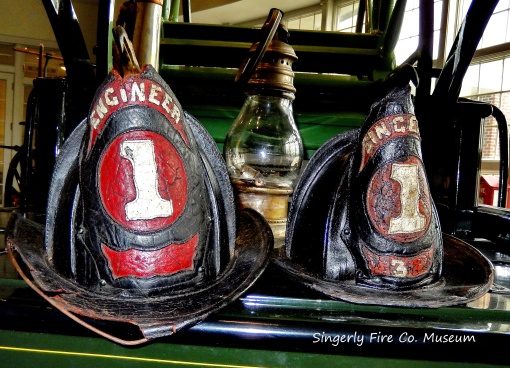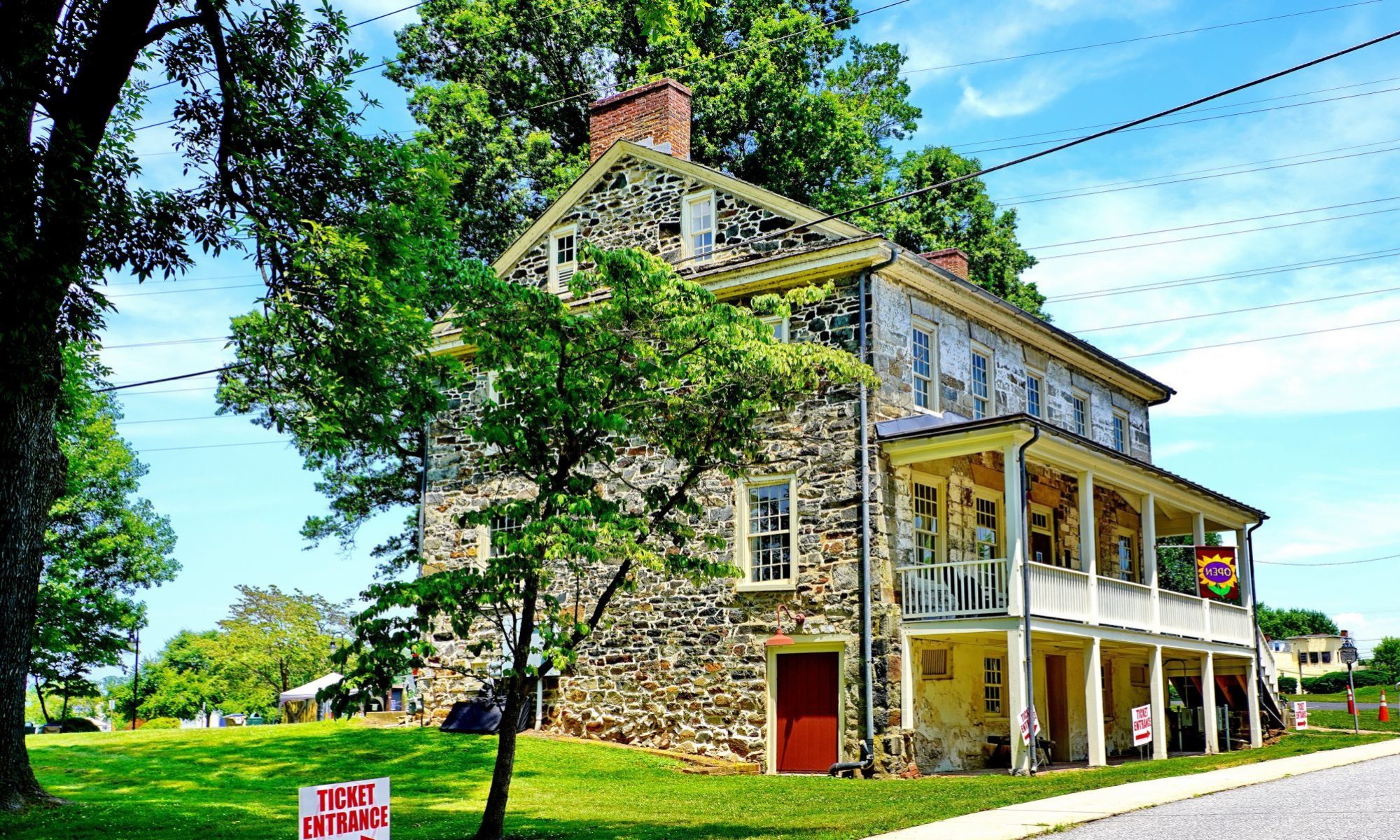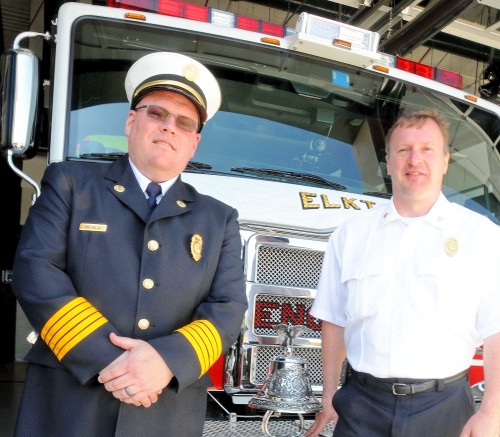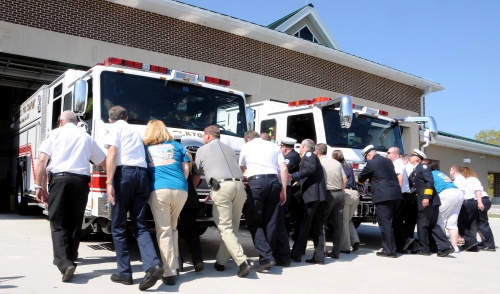The William M. Singerly Fire Company of Elkton formally dedicated its recently renovated and expanded Newark Avenue station today. In celebration of the completion of this important public safety enhancement, a parade of over 80 units made its way through downtown around 1:00 p.m. An hour or so later, a packed house of emergency responders, well-wishers, and public officials assembled at Station 13 for remarks, the playing of the bagpipes, and the unveiling of the station plaque. The ceremony wrapped up, with an old, time-honored, fire service tradition. Members stood in front of the engines and ambulances parked on the outside ramp and gave them a shove, pushing the units into the apparatus bays. The new structure updates the central station, which opened in 1971. The headquarters station provides a new apparatus wing, along with significant renovations to existing areas.
All is Quiet at Retired Fire Station
At Singerly’s first station near the corner of North & Main streets everything was very quiet one night this week as a full moon began its ascent in the nighttime sky. In the late 1940s the company had outgrown its first home. So in 1950 the members rolled up the hose, cranked up the trucks, and moved up the street one block to a greatly expanded headquarters.
Port Deposit Heritage Hosts An Evening With Dr. Beanes – A War of 1812 Living History Presentaton
On Thursday, April 25th at 7 p.m. the Port Deposit Heritage Corporation presents an interesting War of 1812 living history program, “An Evening with Dr. William Beanes.
William Beanes, a well respected Maryland doctor, was captured by the British for his role in arresting and jailing British deserters and stragglers. Following his capture, Georgetown lawyer Francis Scott Key and U.S. Agent for Prisoner Exchange John S. Skinner were charged with securing Beanes release from the British. Before leaving on this mission, Skinner acquired letters from wounded British prisoners of war describing their good treatment at the hands of Americans. British Major General Robert Ross, who had ordered the seizure of Dr. Beans, was initially unwilling to release the doctor. He was later persuaded after reading the letters from the wounded British prisoners.
Although they had accomplished their mission, Beans, Key and Skinner’s return home was postponed when the British decided to attack Baltimore. They were placed on a flag-of-truce ship, anchored at Old Roads Bay on the Patapsco River, eight miles below Fort McHenry.
This should be an interesting program and here is the event poster with more details.
Robert M. Walmsley Elected Sheriff
 Since its founding as Maryland’s tenth county in 1674, many men have served as the jurisdiction’s chief law enforcement officer. Robert M. Walmsley, one of those public servants, was elected to a two year term as sheriff in 1853. At that time the officer could serve only one term, according to state law. He was born in Sassafras Neck in 1804 and at the time of his death in 1879 was in the 75th year of his life. Early in his life he moved to Bell Hill, just outside Elkton, where he took up the milling trade.
Since its founding as Maryland’s tenth county in 1674, many men have served as the jurisdiction’s chief law enforcement officer. Robert M. Walmsley, one of those public servants, was elected to a two year term as sheriff in 1853. At that time the officer could serve only one term, according to state law. He was born in Sassafras Neck in 1804 and at the time of his death in 1879 was in the 75th year of his life. Early in his life he moved to Bell Hill, just outside Elkton, where he took up the milling trade.
Robert was the Democratic sheriff in 1853, in opposition to Jacob Hyland. During his term of office it fell to his lot to perform a very unpleasant duty, an execution. Robert Swift was convicted of murder in 1855, in a case that had been moved here from Harford County. When the day for the hanging came, Elkton was astir at an early hour as Sheriff Walmsley and Deputy Janney took the prisoner out to Red Hill. At the appointed time the two lawmen accompanied the prisoner to the top of the platform on the gallows. There the sheriff placed the noose around the doomed man’s neck and the trap door fell open.
The sheriff always obeyed the stern behest of the law and hesitated not to perform his duties, even it when it was a disagreeable task, the newspapers reported. He was a powerful man and few men ever exceeded him in cool, courage determination, the Cecil Democrat added. That trait of coolness under fire, one that served the sheriff well, occurred a few years earlier when he aided Sheriff Daniel McCauley. Accompanied by the Elkton Guards, a military company, they went to Charlestown to execute an indictment. When an entrance into the home was made, Robert found one man standing at the head of the stairs with a loaded gun, threatening to shoot the first peson that attempted to ascend. Not daunted by the bluster or the bravado, Robert quietly walked up the stairs and catching the gun near the muzzle and wrenching it from his hand.
He died at his home in Elkton on July 22, 1879 and was buried in Elkton Cemetery.
Era Ends in 1963 as Rising Sun Unplugs Telephone Switchboard
The Rural Electrification Administration approved a loan of $545,000 for the Armstrong Phone Company to acquire the Cecil Farmers Telephone Company in 1962. In addition to purchasing the assets of the enterprise, a series of improvements, including a direct dial system and a new central office, were planned. On the day the announcement was made, the Cecil Democrat stopped by and took a picture of the operators juggling the cords and making the connections. On that day in June 1962 Miss Helen Orr, Mrs. Frieda Tome, Mrs. Glenn Meeks, Mrs. Helen Gibson worked the board, while Mrs. Jewelyne Doyle supervised the work. Finally in 1963 an era ended as the switchboard was unplugged and Rising Sun changed over to dial-up service.

For more on the telephone in Cecil County, see the Telephone Operator in Elkton
Relics From Another Age of Firefighting Getting Ready for Station Dedication
Singerly Fire Company volunteers have been busy over the past several week rearranging displays of artifacts in the museum. On this Friday afternoon, these relics of many 19th century fights with the flames and smoke rested on the 1818 Hydraulion and the Rodgers Hand Pumper (came to Elkton in 1859). The top photo, shows two leather helmets that date from the Company’s earliest days, and a much earlier 19th century lantern. In the bottom photo, there is a fireman’s trumpet, used to shout commands at the scene of a fire. It was given to Elkton firefighters by the Washington Fire Company of Wilmington. And there’s a leather bucket.


Perry Point Contains Architectural Gems From 18th Century
The fading rays of the late afternoon sun illuminated the beauty of two 18th architectural gems from Cecil’s past on this fine Saturday in mid-April. The Perry Point Mansion and Mill were built about 1750 by the Thomas family. They sold the 1,800 acre property to the Stump family in 1800. When it was occupied by John Stump II, the Union Army took over the point, using it as a training camp for Army mules. In 1918, the family sold their attractively situated farm, which was then only 516 acres, to the United States Government for $150,000 to be used for the site of an explosives plant. After the Armistice Perry Point was used as a rehabilitation center, supply depot, and psychiatric hospital.
Source: National Register of Historic Places
Tradition and Technology Converge in Civil War Exhibit

By Eric Mease
“Choose Ye This Day, Cecil County and the Civil War” opened to a standing room only crowd on Saturday as the Historical Society of Cecil County unveiled its much anticipated Civil War exhibit.
Visitors saw artifacts from the society’s collection of Civil War memorabilia ranging from life sized portraits to weapons, from uniforms to enlistment papers, and from articles of clothing to pictures. Also on display is information about home life, politics, experiences from the front, and a section dedicated to the 200 African Americans related to Cecil County who fought for the Union. Visitors also experienced living history theatre when the Rev. Joseph T. Brown appeared from out of the mist of time to share his war experiences as a war chaplain, and the Heritage Troupe presented historic skits based on the Civil War era.
Society Board President, Paula Newton said she was happy with the turnout. “There were about 80 people here, both young and old. I was especially pleased that I saw so many new faces. That’s good for our organization that requires constant renewal in order to remain vital.”

It was emphasized that the exhibit did not begin and end with what’s contained in the glass exhibit cases or posted to walls. The exhibit expands into cyberspace with the addition of a newly created Civil War web page on the Historical Society’s web site. Site creator, Mike Dixon, says the web site is crucial to the society’s future. “The future lies not in bricks and mortor, but in internet technology. Historic museums of all kinds are facing declining membership and limited resources. We must reach out to scholars and history buffs alike through new technology or we’ll lose them.”
The constantly evolving page already contains excerpts from the society’s newsletters and historic journal, a catalogue of Civil War soldiers buried in Cecil County, a thesis about African Americans related to Cecil County who fought for the Union, and a finding aid to the “Gerry Collection,” a treasure trove of Civil War and 19th century era manuscripts donated to the society by Dr. Davy McCall. We will soon post Civil War era pictures and a link to the University of Delaware’s project transcribing Rev. Brown’s Civil War diaries.
The society is also working to merge its large collection of Civil War related documents into one area of our library to facilitate easier access to the collection. Finding aides will also be developed to locate specific documents.
Thanks to Lisa Dolor, the curator of this exhibit along with her helpers, Denise and Conor McNeice for composing the exhibit and the University of Delaware’s College of Arts and Sciences Interdisciplinary Humanities Research Center which scanned the Brown diaries.
You are welcome to research our entire collection when the society is open: Mondays and Thursdays from 10 a.m. to 4 p.m. and the first Saturday of every month from 10 a.m. to 2 p.m. You may, of course reach us on line anytime.

Cecil Guardian: Civil War Comes to Life at Society
Cecil Guardian reporter and photographer Bill Hughes wrote a front page piece about the opening of the Historical Society’s Civil War exhibit in this week’s paper. The photojournalist interviewed the exhibit curator, Lisa Dolor, and one of our living history performers, the Rev. Hubert Jicha. Be sure to pick up a copy and read the full story. Thanks Bill and Cecil Guardian for covering the Society’s opening.

U of DE History Majors Crowdsource a Civil War Chaplain’s Diary


An old Civil War chaplain’s diary that has been gathering dust for 150-years and was periodically brought out for some research has been getting an enormous amount of attention lately. This past Monday evening U of DE honors society history students, faculty and staff were pouring over fading pages from another age, scrutinizing those aging entries line by line. Here are some photos from the crowdsourcing party. Completion of this important task will make this valuable Civil War primary source available to a wide audience and the Historical Society is pleased to be working with the University on this new media project. Click here to read the full story.










